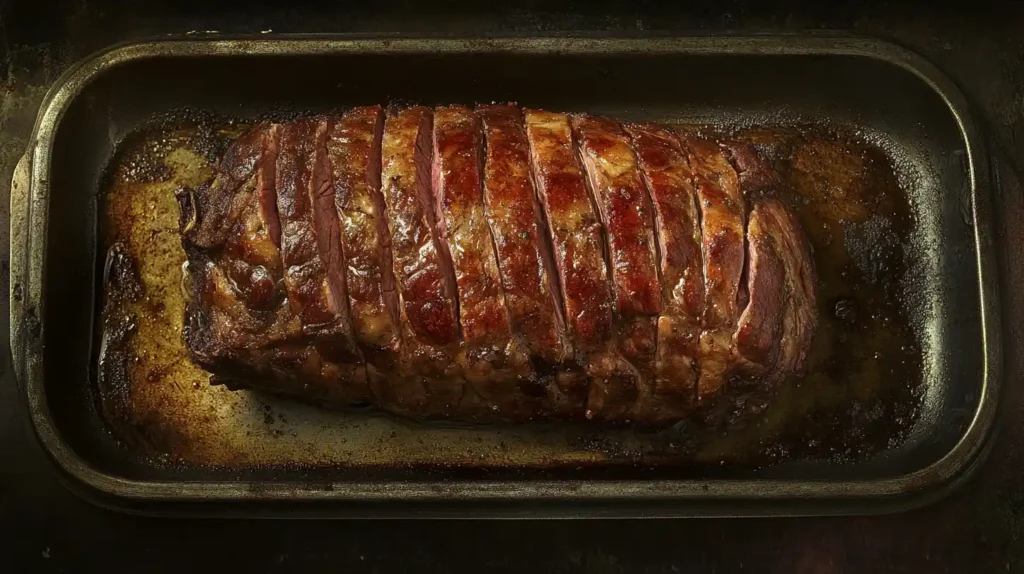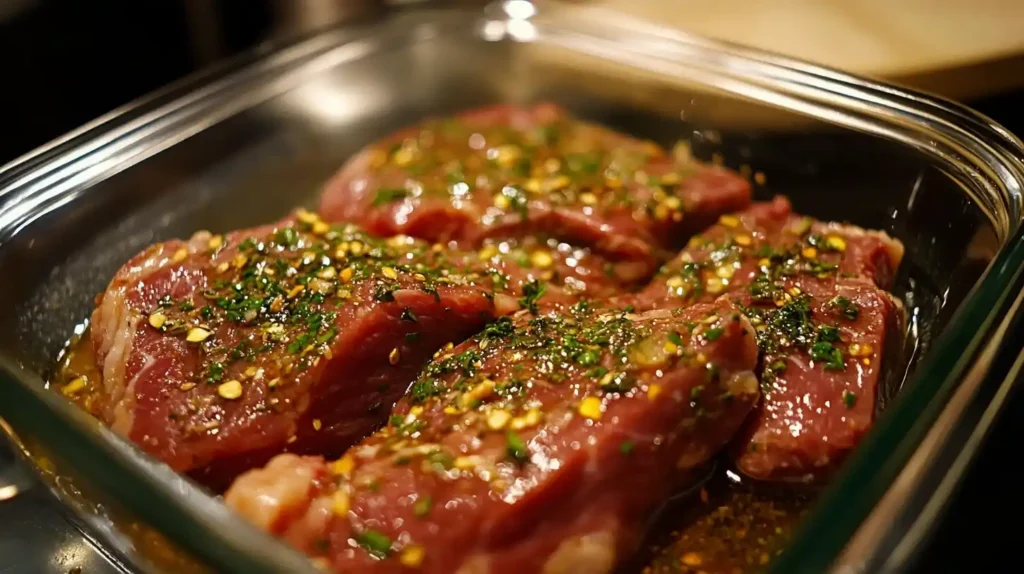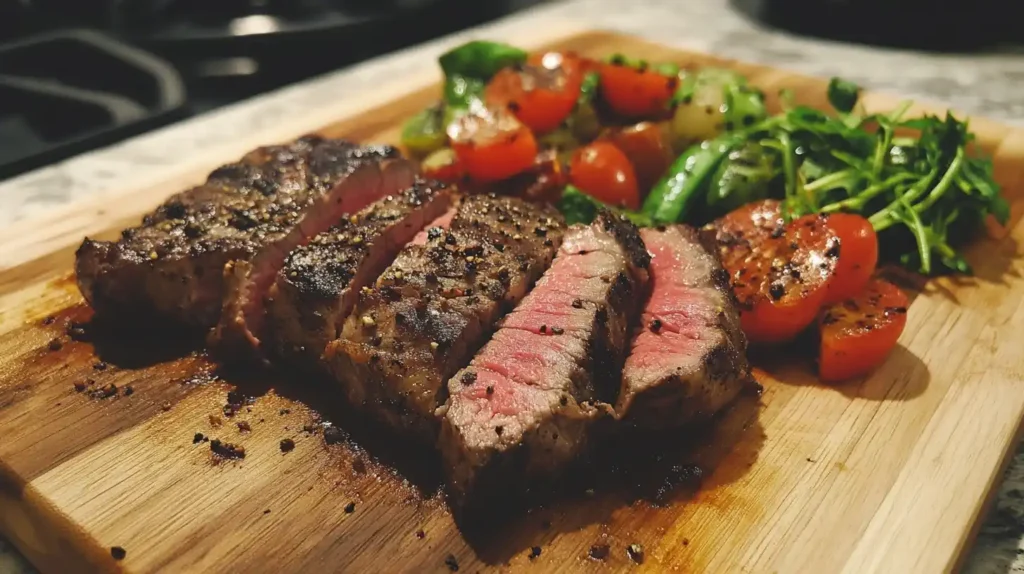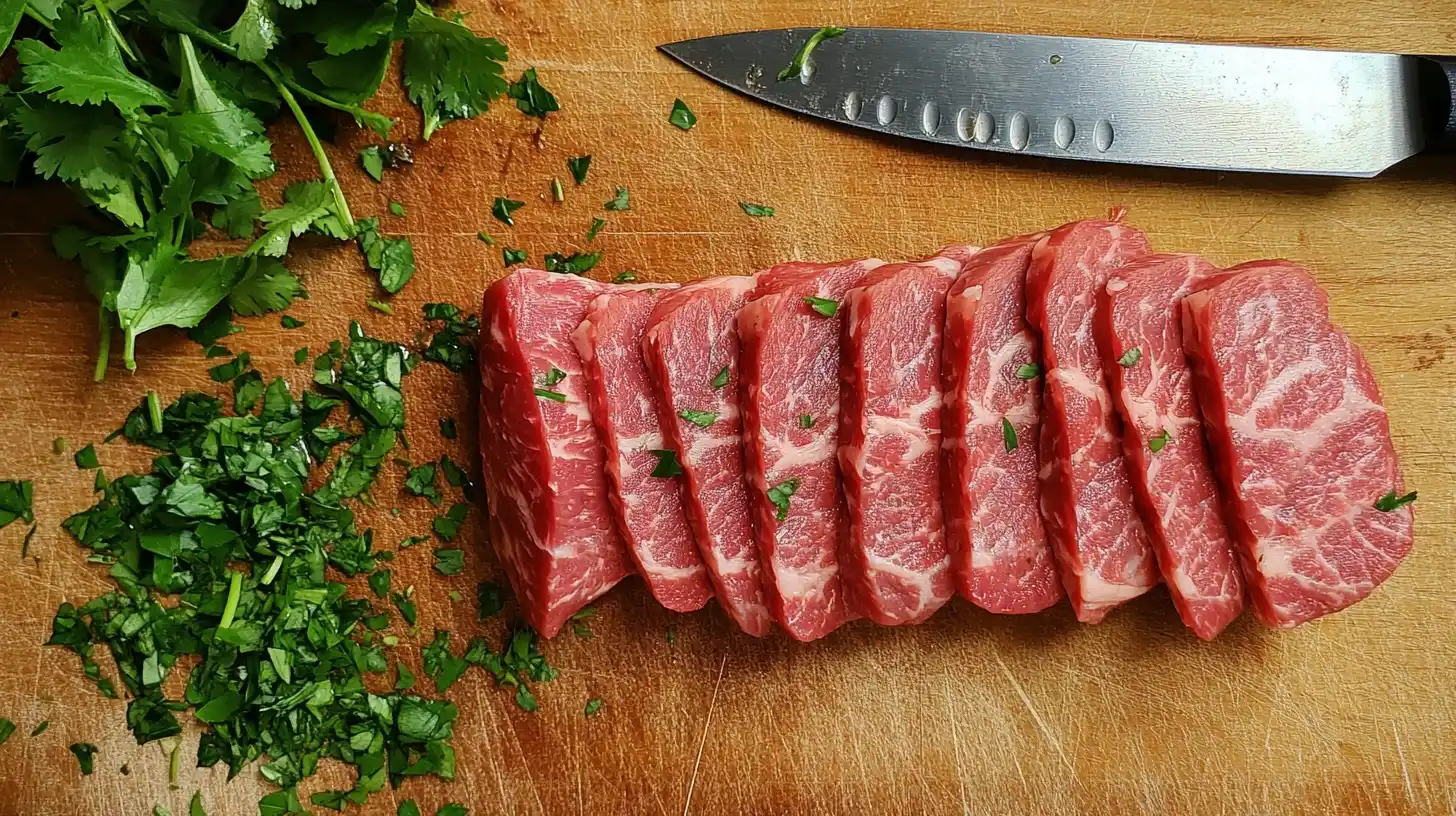Choosing the best cut of beef for sliced beef is key to achieving the perfect combination of flavor, texture, and ease of preparation. Whether you are crafting a deli-style roast beef sandwich or stir-frying a savory meal, selecting the right cut will make all the difference. This guide dives into the top beef cuts, preparation tips, and slicing techniques to ensure your dish shines.
Table of contents
- Why the Right Beef Cut Matters for What Cut of Beef Is Best for Sliced Bee f
- Best Cuts of Beef for Sliced Beef in a What Cut of Beef Is Best for Sliced Beef Guide
- Specialized Cuts for Unique Dishes Like What Cut of Beef Is Best for Sliced Beef
- Essential Tips for Preparing and Slicing Beef for What Cut of Beef Is Best for Sliced Beef
- Lean Cuts for Health-Conscious Eaters Enjoying What Cut of Beef Is Best for Sliced Beef
- Healthy Cooking Tips for Lean Cuts in What Cut of Beef Is Best for Sliced Beef
- Frequently Asked Questions About What Cut of Beef Is Best for Sliced Beef
- Conclusion

Why the Right Beef Cut Matters for What Cut of Beef Is Best for Sliced Beef
When it comes to making sliced beef, the cut plays a crucial role. The best cut of beef for sliced beef ensures the texture is soft, the flavor is rich, and slicing is a breeze. Cuts like top round and flank steak are perfect for their versatility, while strip loin offers premium taste for special occasions.
If you’re exploring other protein options or curious about enhancing your culinary repertoire, you might enjoy this guide on unlocking the hidden flavors of sliced beef.
Thinly sliced beef is popular for sandwiches, stir-fries, and plated dishes. However, each recipe needs a specific type of cut. For example, lean cuts like top round or eye of round are great for sandwiches. On the other hand, flavorful cuts like flank steak work best for stir-fry dishes.
Benefits of Choosing the Right Cut for What Cut of Beef Is Best for Sliced Beef
- Tenderness: The cut determines how soft and juicy your beef will be.
- Flavor: Some cuts have bold flavors; others are mild.
- Ease of Slicing: The right cut is easier to slice thinly and evenly.
The right cut sets you up for success. Now that you know why it matters, let’s dive into the best cuts for sliced beef.
Best Cuts of Beef for Sliced Beef in a What Cut of Beef Is Best for Sliced Beef Guide
Not all beef cuts are created equal. Some are tender, others are flavorful, and a few are just perfect for thin slicing. Below are the best cuts to consider when making sliced beef dishes.

1. Top Round and Bottom Round for What Cut of Beef Is Best for Sliced Beef
When deciding what cut of beef is best for sliced beef, top round and bottom round are go-to choices. These lean cuts are affordable and deliver a mild beefy flavor, ideal for sandwiches.
Preparation Tips:
- Roast at low heat to retain moisture.
- Rest the meat before slicing for maximum tenderness.
Why They’re Great:
- Affordable and widely available.
- Ideal for thin-sliced roast beef and sandwiches.
- Firm texture holds up well in thin slices.
Tips for Preparation:
- Cook at low temperatures to prevent dryness.
- Let the meat rest after cooking to lock in the juices.
- Use a sharp knife to get paper-thin slices.
2. Eye of Round: A Lean Option for What Cut of Beef Is Best for Sliced Beef
If you’re looking for a tender and compact cut, the eye of round is an excellent choice. It is lean like the top round but has a slightly softer texture, making it ideal for cold cuts and stir-fry.
Why It’s a Top Pick:
- Tender yet affordable.
- Works well in slow-cooked or roasted dishes.
- Great for slicing thinly due to its uniform shape.
Preparation Tips:
- Marinate before cooking to boost flavor.
- Slice against the grain to enhance tenderness.
- Avoid overcooking, as it can become dry.
3. Top Sirloin and Strip Loin for What Cut of Beef Is Best for Sliced Beef
These cuts are perfect if you want bold flavor with a bit more fat. The top sirloin and strip loin (also called New York strip) are well-marbled, making them juicy and flavorful.
Why Choose Them:
- Rich, robust flavor.
- Perfect for sandwiches or plated dishes.
- Tender and easy to slice thinly.
Tips for Success:
- Trim the outer fat for cleaner slicing.
- Roast at medium temperatures for the best texture.
- Pair with light seasoning to let the beef’s flavor shine.
Specialized Cuts for Unique Dishes Like What Cut of Beef Is Best for Sliced Beef
Some dishes call for cuts that stand out for their bold flavors or unique textures. These specialized cuts are perfect for recipes like stir-fries, smoked dishes, or grilled meals.
1. Flank Steak as a Top Choice for What Cut of Beef Is Best for Sliced Beef
The flank steak is a favorite for its rich, beefy flavor. Although it’s a lean cut, it has a slight chew, making it ideal for dishes that require thin slicing.
Why It’s Unique:
- Bold and intense flavor.
- Lean and versatile for various dishes.
- Best when marinated and sliced thinly.
Best Uses:
- Stir-fry dishes, as it soaks up sauces well.
- Grilled dishes where the smoky flavor enhances the meat.
Preparation Tips:
- Always slice against the grain to reduce toughness.
- Marinate for at least an hour to tenderize and boost flavor.
- Cook quickly at high heat to avoid drying it out.
2. Chuck and Brisket for a Hearty What Cut of Beef Is Best for Sliced Beef Meal
While these cuts are more commonly used for slow-cooked dishes, they can also work for sliced beef if prepared correctly. These cuts are rich in fat, which melts down to create an incredible depth of flavor.
Why They Stand Out:
- High fat content gives a robust, hearty taste.
- Great for smoked or braised recipes.
- Works well for dishes needing shredded or sliced beef.
Best Uses:
- BBQ brisket, sliced thinly after smoking.
- Braised chuck in rich sauces.
Preparation Tips:
- Cook low and slow to break down the fat and connective tissue.
- Let the meat rest before slicing for better texture.
- Slice across the grain for tenderness.
3. Skirt Steak: A Bold Selection for What Cut of Beef Is Best for Sliced Beef
Similar to flank steak, this cut is thin and packed with flavor. It’s often used in fajitas and stir-fry recipes.
What Makes It Special:
- Intense flavor from its marbling.
- Thin, flat shape makes it easy to slice.
- Best for quick cooking methods.
Preparation Tips:
- Marinate to add layers of flavor.
- Cook at high heat for a short time to avoid toughness.
- Slice very thin for the best texture.
Essential Tips for Preparing and Slicing Beef for What Cut of Beef Is Best for Sliced Beef
Even with the best cut of beef, the way you prepare and slice it can make a huge difference. Proper preparation brings out the full flavor of the meat, while the right slicing techniques ensure tenderness in every bite.

1. Match the Cut to the Recipe
Different dishes require different cuts of beef. Picking the right one saves you time and ensures the best result. Here are some general guidelines:
- Use top round or eye of round for deli-style sandwiches.
- Select flank steak or skirt steak for stir-fry and fajitas.
- Opt for chuck or brisket for smoked or braised dishes.
Matching the cut to the dish makes your cooking process smoother and the final dish more enjoyable.
2. Marinate for Extra Tenderness
Marinating helps tenderize tougher cuts like flank steak or eye of round. It also adds flavor that penetrates the meat. A good marinade balances acid (like vinegar or lemon juice), oil, and spices.
Quick Tips for Marinating:
- Marinate for at least 30 minutes for thin cuts, longer for thicker ones.
- Use soy sauce, garlic, and a touch of sugar for an umami-packed flavor.
- Always pat the beef dry before cooking to avoid steaming it.
3. Cook with Care
Cooking beef the right way ensures it stays juicy and tender. Overcooking dries it out, while undercooking may not bring out the best flavor.
Best Practices:
- Use a thermometer to check doneness (medium-rare is 135°F/57°C).
- Let the meat rest for 10 minutes after cooking to retain juices.
- Avoid slicing immediately after cooking, as the juices will run out.
4. Slicing the Right Way
Slicing beef properly makes it easier to chew and enjoy. The secret lies in slicing against the grain. This means cutting perpendicular to the natural lines of the muscle.
Slicing Tips:
If slicing cooked beef, ensure it’s cool enough to handle.
Use a sharp knife for clean, even slices.
Slice thinly for sandwiches or stir-fry, slightly thicker for plated dishes.
Lean Cuts for Health-Conscious Eaters Enjoying What Cut of Beef Is Best for Sliced Beef
If you’re looking for a healthier option, lean cuts of beef are your best bet. These cuts are lower in fat but still deliver great flavor and versatility. With the right preparation, lean beef can be both delicious and satisfying.
1. Top Round
Top round is one of the leanest cuts available. It’s affordable, widely available, and perfect for slicing thin. Despite its low fat content, it has a robust beefy flavor when cooked correctly.
Why It’s a Healthy Choice:
- Low in fat, high in protein.
- Works well in sandwiches and meal prep.
Preparation Tips:
- Avoid overcooking to prevent it from becoming dry.
- Use a marinade to enhance the natural flavors.
2. Eye of Round
This cut is another lean and budget-friendly option. Its compact shape makes it easy to slice evenly, which is ideal for portion control and meal prep.
What Makes It Great:
- Extremely low in fat.
- Versatile for roasting, slow cooking, or stir-frying.
Cooking Tips:
- Cook it to medium-rare for the best texture.
- Rest the meat before slicing to retain juices.
3. Sirloin Tip Roast
The sirloin tip roast is a lean cut from the round section. It’s slightly more tender than top round and has a mild flavor.
Why It’s a Smart Pick:
- A good balance of leanness and tenderness.
- Perfect for slicing thin for sandwiches or salads.
Preparation Suggestions:
- Season lightly with herbs and garlic for added flavor.
- Roast or grill for the best results.
Healthy Cooking Tips for Lean Cuts in What Cut of Beef Is Best for Sliced Beef
Lean beef cuts like top round and eye of round are not only healthier but also versatile. When considering what cut of beef is best for sliced beef, these options offer a great balance of flavor and nutrition.
Cooking Tips:
- Roast at low temperatures to preserve juiciness.
- Pair with whole grains and fresh vegetables for a balanced meal.
1. Marinate for Maximum Flavor
Lean cuts like top round and eye of round benefit from marinades. A good marinade not only adds flavor but also tenderizes the beef. The acid in marinades, such as vinegar or citrus juice, breaks down tough fibers, making the meat more enjoyable to eat.
Tips for Marinating:
- Combine acidic ingredients (like lemon juice or apple cider vinegar) with oil and spices for a balanced marinade.
- Include herbs like rosemary or thyme for extra aroma.
- Marinate for at least 30 minutes for thin cuts, or up to 12 hours for larger cuts.
2. Use Low and Slow Cooking Methods for What Cut of Beef Is Best for Sliced Beef
Cooking lean beef at lower temperatures helps preserve its moisture and prevents it from drying out. Methods like roasting, braising, and slow cooking are ideal for these cuts.
How to Cook Low and Slow:
- Preheat the oven to 250–300°F (120–150°C) for gentle roasting.
- For braising, use a flavorful liquid like broth or wine to keep the beef moist.
- Cover the beef while cooking to trap steam and maintain tenderness.
3. Sear for Extra Flavor
Searing lean cuts before slow cooking or roasting can add a delicious crust and lock in moisture. The caramelized surface creates a richer flavor profile, even in lean cuts.
Searing Tips:
- Heat a skillet with a small amount of oil until it’s hot.
- Sear the beef for 2–3 minutes on each side before transferring it to the oven or slow cooker.
- Avoid flipping too often to ensure a proper crust forms.
4. Rest the Beef After Cooking for the Best What Cut of Beef Is Best for Sliced Beef Experience
One of the simplest ways to keep lean cuts juicy is by letting them rest after cooking. Resting allows the juices to redistribute throughout the meat, ensuring every slice is moist.
How to Rest Beef:
- Place the cooked beef on a plate or cutting board.
- Cover loosely with aluminum foil to keep it warm.
- Let it rest for 5–10 minutes before slicing.
5. Slice Against the Grain
How you slice lean beef can greatly affect its tenderness. Cutting against the grain shortens the muscle fibers, making each bite softer and easier to chew.
Slicing Guidelines:
- Identify the grain (the direction of the muscle fibers) before slicing.
- Use a sharp knife to cut perpendicular to the grain.
- Slice thinly for dishes like sandwiches or stir-fry.
6. Pair with Healthy Ingredients
To create balanced meals, serve lean beef with nutritious sides. Fresh vegetables, whole grains, and light sauces complement the beef while keeping the meal healthy.
Healthy Pairing Ideas:
- Roast beef with steamed broccoli and quinoa.
- Grilled flank steak with a mixed greens salad and balsamic dressing.
- Sliced sirloin with roasted sweet potatoes and sautéed spinach.
7. Season Lightly for a Healthier What Cut of Beef Is Best for Sliced Beef Dish
Lean cuts often have a clean, natural flavor. Light seasoning enhances this without overwhelming the beef.
Simple Seasoning Blends:
- Salt, pepper, and garlic powder for a traditional flavor.
- Smoked paprika and cumin for a smoky twist.
- Lemon zest and fresh herbs for a bright, fresh flavor.
Frequently Asked Questions About What Cut of Beef Is Best for Sliced Beef
Here are some common questions people ask about choosing and preparing the best cut of beef for sliced beef. These answers will help you make the most of your beef and avoid common pitfalls.
1. What is the Best Cut of Beef for Sandwiches?
For sandwiches, top round and eye of round are the most popular choices. These cuts are lean and simple to slice thinly. They hold their shape well and deliver a clean, beefy flavor that works perfectly in roast beef sandwiches.
2. How Do I Ensure My Sliced Beef is Tender?
Tenderness depends on two key factors: the cut of beef and how you prepare it. Follow these tips:
- Choose cuts like flank steak or top round for their tenderness when sliced thinly.
- Marinate the beef to break down muscle fibers.
- Always slice against the grain for a softer bite.
3. Can I Use the Same Cut for Stir-Fry and Sandwiches?
Yes, cuts like flank steak and top round are versatile enough for both dishes. These cuts are firm yet tender when sliced thinly, making them suitable for quick-cooking methods like stir-frying as well as cold cuts for sandwiches.
4. What Tools Do I Need for Slicing Beef?
For precise, thin slices, you’ll need:
- A sharp chef’s knife or carving knife.
- A meat slicer for perfectly uniform slices.
- A sturdy cutting board to keep the beef steady while slicing.
5. Is it Better to Slice Beef Before or After Cooking?
Most of the time, it’s better to slice beef after cooking. Cooking the beef whole helps it retain more juices, which are crucial for flavor and tenderness. Once it rests, you can slice it as thinly as needed.
Conclusion
Choosing the best cut of beef for sliced beef is the foundation for creating flavorful and tender dishes. Whether you’re preparing deli-style roast beef, stir-fry, or BBQ brisket, the right cut ensures your beef is easy to slice and delicious in every bite.
Lean options like top round and eye of round are perfect for those who want a healthy yet flavorful meal. On the other hand, cuts like flank steak and strip loin are great for bold flavors and versatile recipes. No matter the dish, always remember to slice against the grain and allow the beef to rest after cooking to retain its juices.
With these tips and knowledge, you’re ready to take your cooking to the next level. Experiment with different cuts, preparation methods, and slicing techniques to discover what works best for your kitchen. Start with your favorite recipe and enjoy the satisfaction of perfectly sliced beef!

